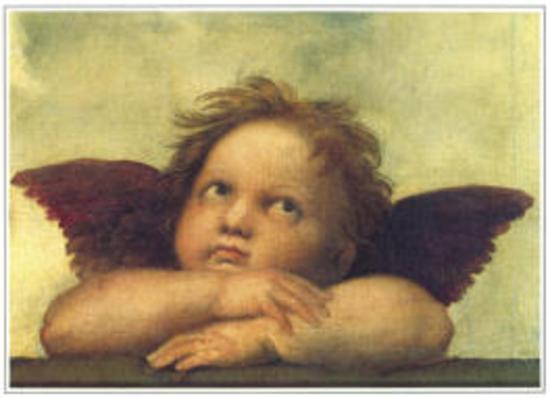By Kimberly Davidson

Take a moment to study this famous picture. No doubt you’ve seen it a hundred times. He’s quite famous in his own right. Heavily marketed, he has been featured in stamps, Christmas cards, postcards, T-shirts, lockets, mugs, wrapping paper and more. What does this picture say to you? What do you think is going on in this little cherub’s mind?

Now take a look at this second picture. This is the original painting, known as “Cherubs from the Sistine Madonna” by Sanzio Raphael. The masterpiece was created in 1514. It is quite different from the first picture. In this, the original picture, the message becomes clearer. These two cherubs are looking up—up to heaven where God resides. The Catholics believe they are Saints Sixtus and Barbara, looking up to Mary.

What’s my point? We tend to “frame” people or situations with our limited view. We “crop” them. For example, we may associate the image of the cherub in the “framed” picture with our teenage son—the son who constantly whines that he’s so bored at home. We judge what’s going on in the cherub’s mind based on our personal judgment of teens who look like this. This is far from reality. In the cropped picture we don’t see the background and history.
I challenge you not to put your own frame of perception and judgment around other people and their stories. See their life, not merely their outside appearance and facial expressions.
As one writer brilliantly stated, “Judgement will always reduce the size of the frame.”
We all do the same thing. We interpret, judge, and label a person/event instantly. Our unique belief results in “our” experience of truth which may be a complete 180 from someone’s else perspective.
William Hazlitt said, “Life is the art of being well-deceived.” Experts says the inclination for self-delusion appears to be weaved into our genetic codes. Have you noticed that we simply believe that our judgment is better than the other guy’s?
It’s never a black and white issue. We forget we have a limited perspective. If someone has hurt us, rather than see their behavior as something malicious directed at us, we should see them for what they are—a broken, sinful human being like all of us. We can try to imagine what an amazing person they could be if he/she found Jesus. We can choose to forgive the flawed human being who did a very bad thing (or things) as a consequence of their own wounding and flawed belief system.
Scripture reminds us, “Make allowance for each other’s faults” (Colossians 3:13); “For all have sinned and fall short of the glory of God. … There is no one righteous, not even one” (Romans 3:10; 23).
Many of my prayers to God have been, “Help me change my mind toward this person and help me to try to see [name] as you see [name].”
I challenge you to take a step back, look at each person and situation in its entirety. Recognize when you are cropping the image, and be open to learning the background and history of the full image.








